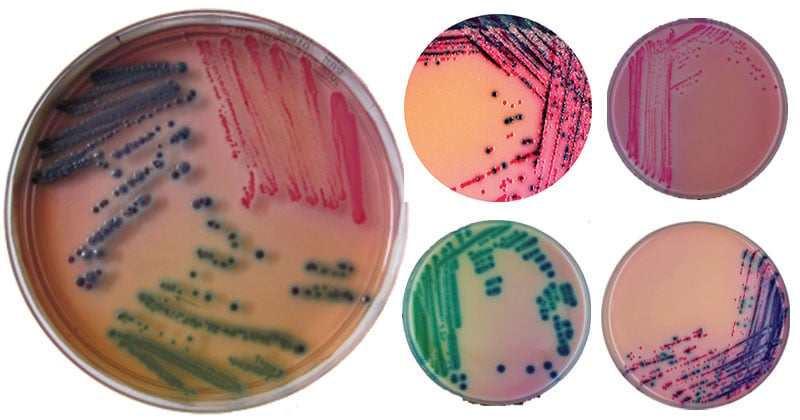The first chromogenic culture medium for the detection of E. coli was invented and patented by Dr. A. Rambach in 1979. This technology is a color-based differentiation method. It is based on soluble colorless molecules (called chromogens), composed of a substrate (targeting a specific enzymatic activity) and a chromophore. When the target organism’s enzyme cleaves the colorless chromogenic conjugate, the chromophore is released. In its unconjugated form, the chromophore exhibits its distinctive color and, due to reduced solubility, forms a precipitate. The result is very specific and clearly distinguishable with the naked eye under normal lighting conditions. With this technique, colonies of specific microorganisms can be recognized by their color at a glance. Rambach Agar eliminates most of those false positives and allows technicians to focus on the real contaminated samples.

Interesting Science Videos
Composition of CHROMagar
| Ingredients | Gm/L |
| Peptone | 8.0 |
| Sodium chloride | 5.0 |
| Sodium deoxycholate | 1.0 |
| Chromogenic mix | 1.5 |
| Polypropylene glycol | 10.5 |
| Agar | 15.0 |
pH 7.4 ± 0.2 at 25°C
Principle of CHROMagar
The nutritive substrates in the Rambach Agar enable Enterobacteriaceae to multiply readily. Sodium deoxycholate inhibits the accompanying Gram-positive flora. Rambach Agar enables species of Salmonella to be differentiated unambiguously from other bacteria which is made possible by adding propylene glycol to the culture medium. Salmonellae form acid with propylene glycol which in combination with a pH indicator gives the characteristic red color to the colonies. Peptone supplies nitrogen and vitamins for the growth of the organism. Sodium chloride maintains osmotic equilibrium thereby maintaining the integrity of cells. For the differentiation of coliforms from Salmonellae, the medium contains a chromogen indicating the presence of β-galactosidase splitting, a characteristic for coliforms. Lactose-fermenting (ß-galactosidase producing) bacteria yield blue-violet-colored colonies. Salmonellae produce acid from propylene glycol and on combining with the pH indicator gives typical pink-red colonies. Other enteric gram-negative bacteria form colorless-yellowish colonies. Salmonella Typhimurium and Salmonella Enteritidis produce pink to red colonies.
Preparation of Medium of CHROMagar
- Add components to distilled/deionized water and bring volume to 1.0 L.
- Mix thoroughly.
- Heat in a boiling water bath or in a current of steam, while shaking from time to time.
- The medium is totally suspended if no visual particles stick to the glass wall.
- The medium should not be heat treated further.
- Complete dissolution with shaking in 5-min sequences is approximately 35–40 minutes.
- Do not autoclave. Do not overheat.
- Cool as fast as possible to 45°–50°C while gently shaking from time to time.
- Pour into sterile Petri dishes.
- To prevent any precipitate or clotting of the chromogenic mix in the plates, place Petri dishes during pouring procedure on a cool (max. 25°C) surface.
- The plates are opaque and pink.
Result Interpretation on CHROMagar
Salmonella → red/intense mauve
Many Coliforms → blue-green or blue-violet
Proteus, Pseudomonas → colorless-yellowish colonies
Uses of CHROMagar
- To differentiate organisms on the basis of the specific color colonies.
- It is a differential-diagnostic culture medium for identifying types of organisms in foodstuffs and clinical samples.
- Rambach agar has potential as a supplementary agar in testing foods for Salmonella
- Rapid detections of Clostridium perfringens, Listeria monocytogenes, Bacillus cereus, and Staphylococcus aureus are additional applications of enzyme detection methods in food and water microbiology by chromogenic agar medium.
References
- Himedia
- Becton, Dickinson Company
- Thermofisher
- Hardy Diagnostic
- Ronald M. Atlas and James W. Snyder. Handbook of media for clinical and public health microbiology. CRC Press. 2014 by Taylor & Francis Group, LLC.

Anyone have any suggestions. Thanks, Rick
I want to make a chrom agar broth to identify staph aureus